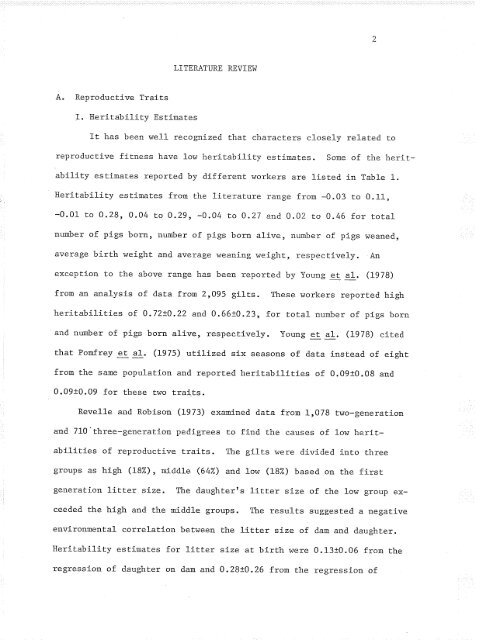Estimation of genetic and phenotypic parameters in a closed ...
Estimation of genetic and phenotypic parameters in a closed ...
Estimation of genetic and phenotypic parameters in a closed ...
Create successful ePaper yourself
Turn your PDF publications into a flip-book with our unique Google optimized e-Paper software.
LITERATURE REVIEI^]<br />
A.<br />
Reproductive Traits<br />
I. Heritability EstÍmates<br />
It has been well recognLzed that characters closely related to<br />
reproductive fitness have low heritability<br />
estimates. Some <strong>of</strong> the heritability<br />
estimates reported by differenË workers are listed <strong>in</strong> Table 1.<br />
Heritability estimates from the literature range from -0.03 to 0.11,<br />
-0.01 to 0.28, 0.04 to 0.29, -0.04 ro 0.27 ar'ð.0.02 ro 0.46 for roral<br />
number <strong>of</strong> pigs born, number <strong>of</strong> pigs born alive, number <strong>of</strong> pigs weaned,<br />
average birth weight <strong>and</strong> average wean<strong>in</strong>g weight, respectívely.<br />
An<br />
exception to the above range has been reported by young et al. (1978)<br />
from an analysis <strong>of</strong> data rlom 2,095 gilts. These workers reported high<br />
heritabílities <strong>of</strong> 0.72!0.22 <strong>and</strong> 0.66!0.23, for total number <strong>of</strong> pigs born<br />
<strong>and</strong> ni¡nber <strong>of</strong> pigs born alive, respectively. young et al. (197S) cited<br />
that Po¡<strong>of</strong>rey et al. (L975) utilized six seasons <strong>of</strong> data <strong>in</strong>stead <strong>of</strong> eight<br />
from the sane population <strong>and</strong> reported heritabilitíes<br />
<strong>of</strong> 0.0910.08 <strong>and</strong><br />
0 .0910.09 f or these trrTo traíts .<br />
Revelle <strong>and</strong> Robison (1973) exam<strong>in</strong>ed data from 1,078 two-generation<br />
<strong>and</strong> 710'three-generation pedigrees to f<strong>in</strong>d the causes <strong>of</strong> 1ow heritabilities<br />
<strong>of</strong> reproductive traits. The gilts were dívided <strong>in</strong>to three<br />
groups as high (78"/"), nr-iddle (647") <strong>and</strong> 1ow (r9i() based on rhe firsË<br />
generation litter size. The daughterrs litter size <strong>of</strong> the 1ow group exceeded<br />
the high <strong>and</strong> the niddle groups. The results suggested a negative<br />
environmental correlation between the litter<br />
size <strong>of</strong> dam <strong>and</strong> daughter.<br />
Heritabilíty est<strong>in</strong>ates for litter size at birth were 0.13t0.06 from the<br />
regression <strong>of</strong> daughter on dam <strong>and</strong> 0.2810.26 from the regression <strong>of</strong>








![an unusual bacterial isolate from in partial fulf]lment for the ... - MSpace](https://img.yumpu.com/21942008/1/190x245/an-unusual-bacterial-isolate-from-in-partial-fulflment-for-the-mspace.jpg?quality=85)





![in partial fulfil]ment of the - MSpace - University of Manitoba](https://img.yumpu.com/21941988/1/190x245/in-partial-fulfilment-of-the-mspace-university-of-manitoba.jpg?quality=85)

